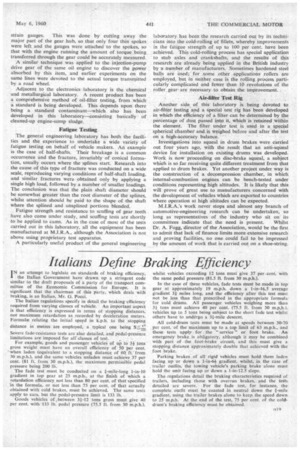Italians Define Braking Efficiency
Page 133

If you've noticed an error in this article please click here to report it so we can fix it.
I N an attempt to legislate on standards of braking efficiency, the Italian Government have drawn up a stringent code similar to the draft proposals of a party of the transport committee of the Economic Commission for Europe. It is significant that the chairman of this party, which deals with braking, is an Italian, Mr. G. Pocci.
The Italian regulations specify in detail the brakingefficiency required from varying classes of vehicle. An important aspect is that efficiency is expressed in terms of stopping distances, not maximum retardation as recorded by deceleration meters. Formulm relating the initial speed in k.p.h to the stopping distance in metres are employed, a typical. one being S-L-',1v2n
Severe fade-resistance tests are also detailed, and pedal-pressure limitations are imposed for all' classes of test.
For example, goods and passenger vehicles of up to 3+ tons. gross weight must have an overall efficiency of 50 per cent. when laden (equivalent to a stopping distance of 60 ft.' from 30 m.p.h.), and the same vehicles unladen must achieve 37 per cent. (81 ft. from 30 m.p.h.), the maximum permissible pedal pressure being 200 lb.
The fade test must be conducted on a 1-mile-long 1-in-10 gradient in top gear at 25 m.p.h., at the finish of which a retardation efficiency not less than 80 per cent. of that speCified in the formula, or not less than 75 per cent, of that actually obtained with cold brakes, must be achieved. The same tests apply to cars, but the pedal-pressure limit is 133 lb.
Goods vehicles of ,between 31-12 tons gross must give 40 per cent. with 133 lb. pedal pressure (75.5 ft. from 30 m.p.h.),
whilst vehicles exceeding 12 tons must give 37 per cent, with the same pedal pressure (81.5 ft. from 30 m.p.h.).
In the case of these vehicles, fade tests must be made in top gear, at approximately 19 m.p.h. dawn a 1-in-16.5 average gradient 31 miles long, and the efficiency after this test must not be less than that prescribed in the appropriate formula. for cold drums. All passenger vehicles weighing more than 3+ tons must achieve 40 per cent. (75.5 ft. from 30 m.p,h.), vehicles up to 5 tons being subject to the short fade test whilst others have to undergo a 31-mile descent.
All cold-drum tests must be made at speeds between 30-70 per cent. of the maximum up to a top limit of 63 m.p.h., and these tests apply for the " service " or foot brake. An emergency brake is obligatory, although it may be combined with part of the foot-brake circuit, and this must give a stopping distance approximately double that achieved with the foot brake.
Parking brakes of all rigid vehicles must hold them laden facing up •or down a 1-in-64 gradient, whilst, in the case of trailer outfits, the towing vehicle's parking brake alone must hold the unit facing up or down a I-in-12.5 slope.
The regulations detail the braking characteristics required of trailers. including those with overrun brakes, and the tests detailed are severe. For the fade test, for instance, the complete outfit must be coasted in neutral down the .1-mile gradient, using the trailer brakes alone to keep the speed down to 25 m.p.h.. At the end of the test, 75 per cent. of the colddrum's braking efficiency must be obtained.




































































































































































































































































